Perhaps Mr. Sergio Carnevalli, as a poor prisoner in Hungary during the First World War, would never have imagined one day going down in history as the founder of a very prestigious manufacturer of fishing reels, so prestigious as to be, together with ALCEDO and ZANGI, a reference point of Made in Italy on the large and very important American market.
Yet fate, but also his talent, wanted him to learn the profession of mechanic in Hungary, while also finding a wife who in 1918 will give him a son, Emilio.
It will be he who will lead CARGEM until 1984, making it the last Italian firm in great style to close its doors.
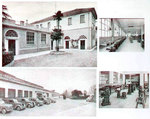
The production site of the CARGEM company

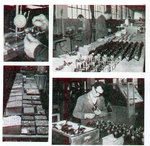
The three previous images are taken from the first book "Alcedo e Cargem" by his friend Silvano Baraldi.
What can be the secret of such longevity?
In my opinion, the answer is very simple: the undisputed quality of the products combined with an intelligent advertising and marketing policy.
"PRECISION MECHANICS"
This is the name of the workshops where, in the 1930s, the very first prototype, still without a name, of what will be the famous “CIGNO” (Swan) was produced. This very first prototype is similar to the famous Swiss BERNA reel, which was already well established at that time.
The very few prototypes are not perfectly alike; with a good dose of certainty, we can date them according to the length of their "finger-stop", progressively smaller and smaller up to a simple protuberance that characterizes the "definitive" models, called “CIGNO”.
Even this protuberance is not always the same: in the first three models (manual line pick-up) it still has the appearance of a “finger stop”, while in the models with “full bail arm” it is more rounded, and even on the leg of the foot there is no longer the “half ring”.
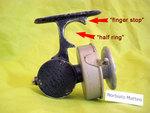
This very first prototype is similar to the famous Swiss BERNA reel.

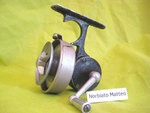
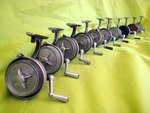

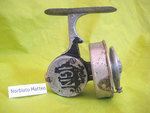

The photos that have a yellow background belong to the friend and great collector Matteo Norbiato.
In the meantime we arrive at the end of the war (WWII), and here is the first turning point: Sergio Carnevalli becomes the sole owner of the workshops, which from that moment put the construction of reels first and take the name CARGEM, (acronym of Carnevalli and Gemonio).
The latter (Gemonio) is the small town in Northern Italy, in the province of Varese, where the workshops were based.
Two new models were born in a few years; the beautiful "DUE PESCI" (Two Fishes) and the cheaper "STELLA ORO" (Gold Star) with external toothed crown, a rare and highly sought-after reel.
The first export attempts certainly date back to the last “40 or early “50 years; on some “CIGNO” latest model and rarely on some "DUE PESCI" with anti-revers button on the side of the body (always the latest model), the inscription "MADE IN ITALY" is engraved.
The same writing can be found on the most recent "STELLA ORO".
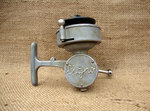

Here is a rare 1948 CARGEM advertisement
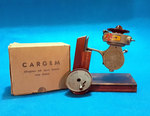
Model "Due Pesci" - (Two Fishes)
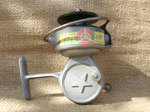
Model "Stella Oro" - (Gold Star)
Perhaps not everyone knows that this last reel exists in two versions: the first does not show on the body, together with the star, the wording "MADE IN ITALY", present instead on the second version.
All of the above is undoubtedly part of the first export attempts, which however will find their definitive path with the advent of Carnevalli Junior (Emilio) at the helm of the company, as we immediately see.
THE 1950s WERE RUNNING.

In 1956 Emilio Carnevalli took over from his sick father.
The "remakes" of the three models of the company are from that period; with a few simple modifications the following models will be produced:
• the "STELLA ORO" becomes the "CARGEM 11" (straight foot with medal)
• the "CIGNO" becomes the "CARGEM 22" (straight foot with medal)
• the "DUE PESCI" becomes the "CARGEM 33" (with the body painted in rough black and with a large gold colored medal) not to be confused with the much more famous "33" (Mignon and Mignon U. L.), a small size reel that will later be a resounding success!
The names given to the new reels (11, 22 and 33) suggest an intention, at least initially, to keep the range of only three types of models, while exporting them.
But, despite this, the “revolution” of the range takes place in a short time. How?
We will see it in the second part.
Article written by Roberto Granata in collaboration with Sergio Di Marco
.
